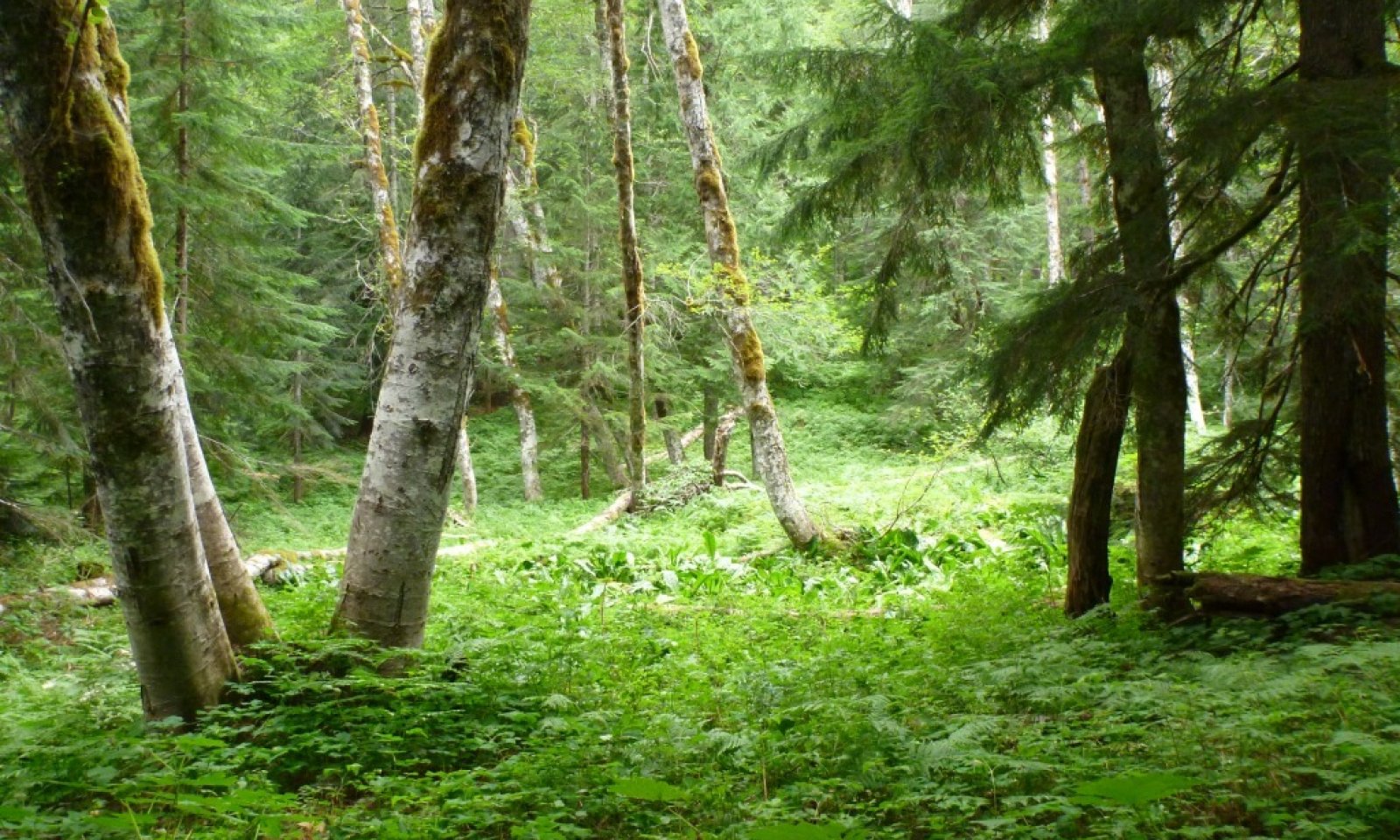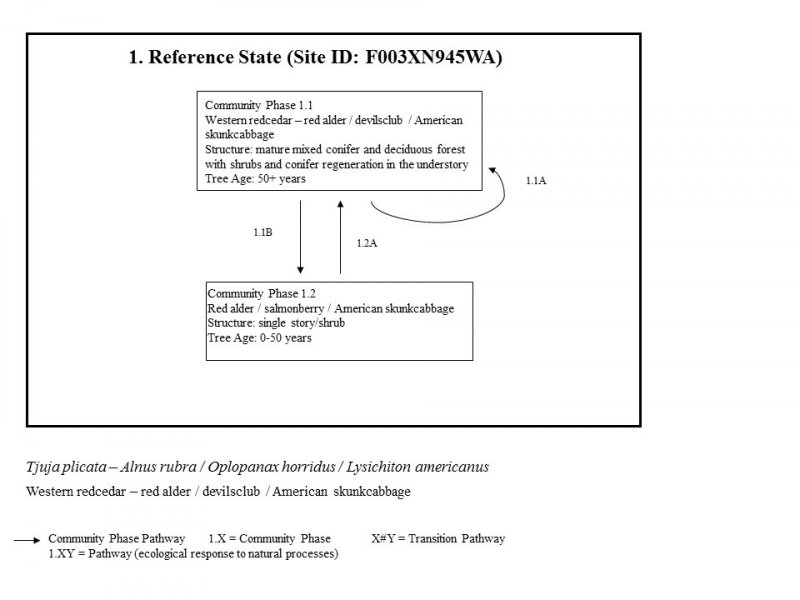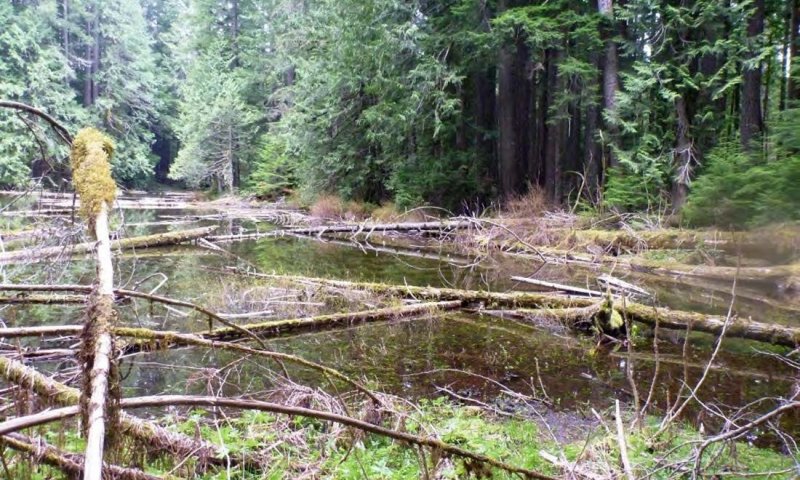

Natural Resources
Conservation Service
Ecological site F003XN945WA
Southern Washington Cascades Wet Low Cryic Coniferous Forest
Last updated: 1/30/2025
Accessed: 12/05/2025
General information
Provisional. A provisional ecological site description has undergone quality control and quality assurance review. It contains a working state and transition model and enough information to identify the ecological site.
MLRA notes
Major Land Resource Area (MLRA): 003X–Olympic and Cascade Mountains
Steep mountains and narrow to broad, gently sloping valleys characterize this MLRA. A triple junction of two oceanic plates and one continental plate is directly offshore from Puget Sound. Subduction of the oceanic plates under the westerly and northwesterly moving continental plate contributes to volcanic activity in the Cascade Mountains. Movement among these plates has resulted in major earthquakes and the formation of large stratovolcanoes. The Cascade Mountains consist primarily of volcanic crystalline rock and some associated metasedimentary rock. The mean annual precipitation is dominantly 60 to 100 inches, but it is 30 to 60 inches on the east side of the Cascade Mountains.
The soil orders in this MLRA are dominantly Andisols, Spodosols, and Inceptisols and minor areas of Entisols and Histosols. The soils are dominantly in the frigid or cryic temperature regime and the udic moisture regime. The soils generally are shallow to very deep, well drained, ashy to medial, and loamy or sandy. They are on mountain slopes and ridges.
Ecological site concept
This ecological site is in cold, wet areas at middle to high elevations (1,800 to 5,700 feet) of Mount Rainier National Park. Climate is a key component in the succession of the forest dynamics. The site is in depressions and swales and on terraces and debris aprons that have a seasonal high water table.
The soils that support this ecological site are in the cryic soil temperature regime and the aquic soil moisture regime. They are poorly drained and very deep, and they have a seasonal high water table at the surface to a depth of 10 inches below the surface some time during the growing season. The soils are subject to frequent periods of ponding in April, May, and June. The most common natural disturbance is ponding. The volume and longevity of the ponding determine the effect on the dynamics of the forest.
Western redcedar (Thuja plicata) and red alder (Alnus rubra) are the most common overstory species, but western hemlock (Tsuga heterophylla), Douglas-fir (Pseudotsuga menziesii), and Pacific silver fir (Abies amabilis) are present. The root penetration of western redcedar makes it well adapted to forested swamps. An herb layer consisting of American skunkcabbage (Lysichiton americanus), western swordfern (Polystichum munitum), deer fern (Blechnum spicant), western oakfern (Gymnocarpium dryopteris), five-leaved bramble (Rubus pedatus), and twinflower (Linnaea borealis) is in scattered areas.
Associated sites
| F003XN941WA |
Southern Washington Cascades Wet Frigid Coniferous Forest The vegetation in ecological site F003XN945WA has commonalities to that of site F003XN941WA; however, site F003XN945WA receives more precipitation and is commonly located at higher elevations. |
|---|
Similar sites
| F003XN946WA |
Southern Washington Cascades Moist Low Cryic Coniferous Forest Ecological F003XN945WA, Southern Washington Cascades Wet Low Cryic Coniferous Forest, has features similar to those of sitesF003XN946WA, Washington Cascades Moist Low Cryic Coniferous Forest. Ecological site F003XN945WA is wetter than site F003XN946WA. It is prone to frequent periods of ponding and it has a higher seasonal water table. As a result, site F003XN945WA supports species adapted to wetness, such as western redcedar, red alder, and American skunkcabbage. Ecological F003XN946WA is drier, and it supports species such as Pacific silver fir, western redcedar, and devilsclub. |
|---|---|
| F003XN947WA |
Southern Washington Cascades Low Cryic Coniferous Forest Ecological F003XN945WA, Southern Washington Cascades Wet Low Cryic Coniferous Forest, has features similar to those of site F003XN947WA, Washington Cascades Low Cryic Coniferous Forest. The soils of site F003XN947WA are well drained. Species adapted to the drier conditions, such as Pacific silver fir, western hemlock, and black mountain huckleberry, are common. |
Table 1. Dominant plant species
| Tree |
(1) Thuja plicata |
|---|---|
| Shrub |
(1) Oplopanax horridus |
| Herbaceous |
(1) Lysichiton americanus |
Click on box and path labels to scroll to the respective text.


